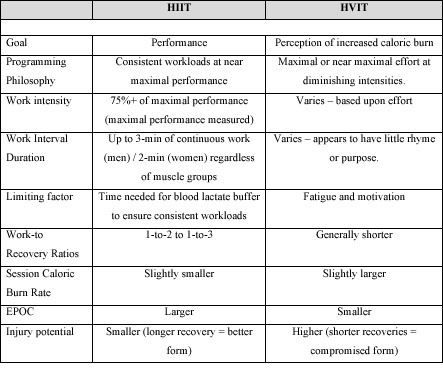High-intensity interval training (HIIT) is all the rage in the fitness world. No doubt you’ve seen various benefits touted just about everywhere, but what is the actual science behind this training design? Would a high-volume interval training (HVIT) approach better meet training goals, or perhaps a combination approach of variable-intensity interval training (VIIT)?
Discover the differences and how to apply the variables of quality and quantity of movement for better results. It doesn't matter if you are a strength and conditioning coach or a personal trainer, all can benefit from knowing the difference between HIIT, HVIT, VIIT (and even SIT).
Look just about anywhere in fitness these days and you’d be hard-pressed to miss some program, product or menu advertising high-intensity interval training (HIIT). So why are these programs trending and so popular? One undeniable fact is the time-efficiency in which an individual can achieve comparable results to those attained through higher-volume, lower-intensity workouts (4).
Research demonstrates similar results with up to 90% less training volume and up to 67% less time commitment (5), and in an era where time has become such a precious and valued commodity, the popularity of HIIT comes as no surprise.
Studies also demonstrate how this training modality is not solely limited to improving fitness markers (e.g., aerobic and anaerobic performance), but delivers positive health improvements like blood pressure and glucose sensitivity (6). Regardless of this research, perhaps the most influential driver of this trend still lies with the perception that HIIT training increases overall caloric burn between the combined effects of the session and the excess post-exercise oxygen consumption (EPOC or afterburn).
Unfortunately, perception and reality are not always the same, and as fitness professionals, we hold the responsibility of educating clients and club members to the truth. Nonetheless, individuals continue to flock in droves to HIIT workouts and programs that they (a) don’t thoroughly enjoy, but perhaps tolerate in the hopes of achieving some desired transformation, or (b) shouldn’t undertake given their lack of adequate preparation (levels of stability and mobility) or conditioning levels. Considering the latter point, it should be concerning that chronic or overuse-type exercise-related injuries in recreational and sports facilities have increased by an average of 4% over the past 10 years (7).
What is HIIT Training?
There is also a general lack of understanding within the fitness industry of what truly constitutes HIIT training and what it is intended to accomplish. What many describe as HIIT is more likely high-volume interval training (HVIT) or, in a best-case scenario, variable-intensity interval training (VIIT).
Each can be effective as long as the practitioner understands their unique purpose and programs accordingly. As professionals, it is imperative to understand that extreme conditioning programs (i.e., training hard rather than smart) are more often than not, an unwise approach to programming for most individuals.
Bergeron and colleagues (8) state that many characteristics of these conditioning workouts disregard current standards for developing muscular fitness which is concerning. For example, repetitive, timed, maximal or near-maximal efforts incorporating short or insufficient recoveries, a characteristic of many popular HIIT programs, may predispose individuals to overreaching or overtraining that can elevate oxidative stress and cellular damage beyond autophagy to suppress immune responses, and impair exercise technique.
Which, consequently increases the risk of musculoskeletal strain and injury. The focus of this article is to help differentiate between these three training modalities by reviewing key bioenergetic and programming principles, and to create a sense of purpose and appropriateness behind whichever modality is aligned with the client’s or group’s unique needs and desires.
Read more: HIIT Workouts - Programming, Exercises, and Benefits
The Energy Pathways
One common misconception about energy pathways is the belief that the anaerobic systems only contribute during high-intensity exercise when our ATP demand exceeds the maximal capacity of our aerobic pathway. In reality however, they are always contributing to the energy we need by providing immediate energy at any point of time during any change in activity or exercise intensity (e.g., interval training, sitting to standing, walking to initiating a light jog). Now consider the following points:
- The origins of true HIIT lie within sports conditioning and hold an explicit purpose – making athletes bigger, stronger, faster and more explosive by implementing overload and specificity to training, For example, a power athlete performing a 225 lb.1RM power clean would train at near maximal loads and rates to improve his maximal performance and not train with 125 lbs. for higher repetitions or longer durations. Near-maximal loading and rate training constitutes HIIT, whereas 125 lb. set stimulates power endurance or submaximal performance, which is not HIIT, but HVIT. Likewise, a wide receiver running a 4.5-second, 40-yard dash would train at near maximal speed with a goal to improve upon his 40-yard time and not perform a high-volume of continuous bouts at 6-seconds because that is the pace he can sustain.
- In essence, never confuse maximal performance with maximal effort as they are very different. The above-mentioned examples of improving performance (1RM, fast 40-yard dash) represents performance – intensity, whereas the sub-maximal, sustained work (e.g., anaerobic capacity, power endurance) represent something else – volume.
- Human capacity to sustain intense bouts of work that rely significantly upon the two anaerobic pathways (i.e., capacity of fast glycolytic – primarily, and the phosphagen system) is generally between two to three minutes for most individuals (Table 1-1). Work intervals exceeding these durations regardless of whether it is performed as one continuous exercise or as a circuit will progressively rely more upon the aerobic pathway and mandate lower-exercise intensities. For example, leg ergometry studies demonstrate 96% contribution of energy from the anaerobic pathways with 10-seconds of work (sustaining almost 100% of maximal power output); 75% contribution at 30-seconds (sustaining 75% of maximal power output); 50% contribution at 60-seconds (sustaining 35% of maximal power output) and only 35% contribution at 90-seconds (sustaining 31% of maximal power output) (9, 10).
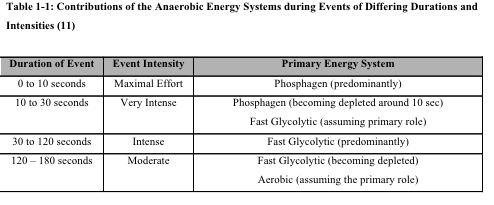
- Although the anaerobic pathways provide an immediate, but limited supply of energy, they recover very slowly once exhausted.
- The time-delay to achieve steady-state (aerobic dominance) generally takes between 90-seconds and 4-minutes, depending upon the modality and intensity of the activity, and the exerciser’s conditioning level – explaining in part why the use of heart rate during non-steady-state or interval training to measure intensity is generally invalid.
Considering the general nature of most interval-type workouts, this article will briefly review key bioenergetic concepts of the fast glycolytic pathway (glycolysis) or lactate system, and not the phosphagen system. By definition, glycolysis represents the metabolic pathway that breaks down glucose (from muscle glycogen) into two pyruvate molecules (12).
While pyruvate is technically the end product of glycolysis, it experiences two fates; either being shuttled into the mitochondria for aerobic respiration or being converted to lactate in the absence of adequate oxygen. What is important to remember is that the fate of pyruvate does not follow an all-or-nothing principle (i.e., it can progress to both simultaneously, depending on the availability of oxygen).
The quantity of pyruvate that enters the mitochondria is contingent on the capacity of the aerobic pathway (e.g., availability of oxygen, size and number of mitochondria). Any excess pyruvate that cannot pass to the mitochondria are converted to lactic acid that quickly dissociates into lactate and a hydrogen ion because lactic acid is not stable in an aqueous environment (and many body tissues are composed of water).
The small amounts of ATP manufactured during glycolysis are utilized by the muscle cells which simultaneously also produce hydrogen ions as ATP molecules split. Normally, these hydrogen ions are passed to the mitochondria during aerobic respiration, but under non-steady-state (anaerobic) exercise, these ions are produced very rapidly and may not all be capable of passing to the mitochondria.
Unfortunately, any accumulation of hydrogen ions results in metabolic acidosis within the muscle tissue (lowering tissue pH levels). This acidosis produces an inhibitory effect on of many glycolytic enzymes (making less energy available) as well as impeding calcium’s ability to enable muscle contraction within the cell.
Consequently, these hydrogen ions must be removed from the cell to allow it to continue working. The combination of pyruvate with two hydrogen ions to form lactate (plus hydrogen) can be cleared from the muscle cell into the blood. The accumulation of hydrogen ions within the cells is also believed to increase pain receptor sensitivity within muscles, offering an explanation why individuals experience a muscle ‘burn’ during high-intensity exercise.
The human body is constantly producing lactate given how certain cells (e.g., red blood cells) lack mitochondria. At rest and under steady-state exercise conditions, the body maintains a balance between lactate production and its removal as lactate can be converted back to pyruvate and then converted back to glucose or used as a fuel (13). The hydrogen ions spilling into the blood are buffered to prevent blood pH changes which could potentially damage various circulating proteins (e.g., red blood cell, white blood cells, hormones, enzymes) (Figure 1-1). A unique function of sodium bicarbonate (NaHCO3) is that it acts as our principal hydrogen buffer.
As illustrated in Figure 1-2, sodium or potassium in the blood binds with lactate to form a compound that can enter the cell for use as a fuel. The remaining bicarbonate binds with hydrogen to form carbonic acid (H2CO3), a weak acid that then dissociates into water and carbon dioxide. Although we have no real need to remove this metabolic water from the body, the carbon dioxide can be expelled via the lungs.
Figure 1-1: Lactate and hydrogen clearance into blood
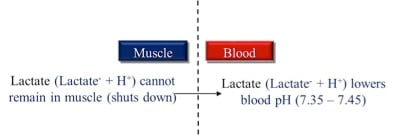
While cells spill lactate and hydrogen into the blood that is subsequently buffered, it is simultaneously regenerating this buffer using sodium, water and carbon dioxide. The moment at which the rate of lactate buffer regeneration fails to maintain pace with its rate of depletion is termed Onset of Blood Lactate Accumulation (OBLA), a term sometimes referred to as lactate threshold by practitioners although they are not technically the same.
At this point, the blood can no longer accept hydrogen ions as it needs more time to regenerate its buffer. Consequently, hydrogen ions now accumulate within the muscle cell, impairing its ability to perform biological work.
The key takeaway for practitioners to understand is that this energy system is not limited by what the muscle can or cannot do, but by the capacity of the blood to buffer and regenerate its buffer.
Therefore, a circuit targeting different muscles where one believes may enable greater work-rates over the duration of the session may still prove to be problematic given how each muscle is clearing lactate into the same bloodstream. The limiting factor when training this energy system has more to do with the time needed to regenerate the lactate buffer within the blood and less to do with the muscles themselves.
Figure 1-2: Buffering protons with sodium bicarbonate
Note: It is important to note that the major function of this process is to buffer hydrogen ions with sodium bicarbonate that can then be released as CO2 and H2O.
Training the Fast Glycolytic System
Few studies have provided results that can be used to generate definitive guidelines for choosing specific work-to-rest ratios where the lactate buffer can regenerate itself sufficiently to tolerate another high-intensity work interval. As mentioned previously, the principles of specificity and overload must be applied appropriately by manipulating key programming variables (FITR – frequency, intensity, training interval, recovery interval).
As this system generally begins to contribute significantly after 10 – 15 seconds and lasts approximately 2 – 3 minutes in most individuals, the guidelines provided in Tables 1-2(a) and 1-2(b) can serve as a programming template to start (11).
Table 1-2(a): Training Variables for the Fast Glycolytic System
| Typical Bout Duration | % Maximal Performance ** | Work-to-Recovery Interval ** | Type of Recovery |
| Start with 30 sec * | 75 – 90% | 1:2 – 1:3 | Active (light loads) |
| * Should ultimately match needs of the individual, sport or goals of the program.** This should not be confused with % of maximal effort as one experiences fatigue. | |||
Table 1-2(b): Recovery Variables for the Fast Glycolytic System
| Recovery between Workouts | Training Sessions per Week | Complete Energy System Recovery |
| 48 hours | 2 – 3 x | Blood lactate return to baseline within 30 – 60 minutes following intense exercise. |
If the recovery interval is inadequate, this system gradually depletes itself over successive repetitions to the point where desired intensities can no longer be sustained. As mentioned previously, continuing to train under compromised conditions must then be questioned given the diminished training efficacy and increased potential for injury.
Many popular workouts today incorporate intervals that target this energy pathway, but fail to accommodate appropriate recoveries. For example, a coach may implement 60-second work bouts with only 30-second recovery intervals and wonder why the work rate is diminishing by the 4th or 5th minute (not differentiating performance from effort).
However, if the coach realized that the fast glycolytic system can only sustain 2 – 3 minutes of work at 75 – 90% of maximal performance, he or she may implement 60-second intervals with perhaps a 30-second recovery for 3 intervals, then take a 2½ to 3-minute light-active recovery, before repeating this format.
Each aggregated set would equal 180-seconds of work (3 x 60-seconds) at which point work rate is most likely no longer sustainable, thereby justifying a longer recovery to regenerate the blood’s buffer in order to maintain higher-intensity (performance, not effort) work rates. Recoveries should always be active (light movement) and involve the exercising muscles as this helps expedite hydrogen and lactate out of the cells and into circulation.
Gender Differences
Over recent years, researchers have begun examining bioenergetic differences between men and women (14, 15). Given how women generally have lower concentrations of type II fibers than men (fibers more responsible for anaerobic respiration), it is believed that they have a lower capacity for anaerobic exercise in comparison to men. This assumption is further supported by smaller blood volumes, thus holding smaller quantities of lactate buffer, in females.
There has also been new research into the role of estrogen and the anaerobic pathways. Estrogen is believed to reduce the efficiency of enzymes involved within these pathways, reduce the rate of energy production and reduce the rate of conversion of pyruvate to lactate which slows lactate clearance from the muscle. Collectively, these factors diminish the overall efficacy and efficiency of the anaerobic pathways in women, which merits consideration for programming.
Although no clear guidelines exist, the overall takeaway is that intervals for women should most likely not be as challenging as they are for men (as measured by absolute power production – watts, or load); the work intervals probably need to be shorter in duration given their reduced ability to produce and clear lactate as quickly, but the recovery intervals can be shorter in duration (e.g., 1-to-2 work-to-recovery ratio or less) as the amount of lactate buffer to be regenerated is smaller.
EPOC or Afterburn
The additional calories expended through EPOC is another myth often marketed with these programs. The unfortunate reality is that the role of EPOC in weight loss is largely unsubstantiated (16). It has been concluded that exercise intensity (HIIT) has a greater role in EPOC variability compared to exercise duration or volume (HVIT) (17). Knab and colleagues (18) studied ten male participants who completed two separate 24-hr visits to a metabolic chamber (one exercise and one rest day).
The exercise day consisted of 45-minutes of cycling at an intensity of 73% of VO2max (generally regarded as higher-intensity with heart rates over 85% of maximal performance). The exercise bouts expended 519 kcal and EPOC remained elevated above resting levels for 14 hours post-exercise, resulting in an impressive total of 190 kcal (13.5 kcal per hour average or a little over half a Starburst™ candy).
Accumulated three times a week over 52 weeks amounts to 8½ lbs. in one year, but it is important to note that the intensity of exercise performed by these participants was vigorous and unlikely to be continuously sustained by most individuals for 45 minutes. Studies involving more moderate volumes and moderate intensities only produced the equivalent to ½ - 3 pounds of additional energy over the period of one year.
The general conclusion on EPOC is that is only generates approximately 7% of the total energy expenditure of exercise. For example, a workout burning 300 kcal may only yield 21 EPOC calories. While EPOC may be limited in its contribution to weight loss, it has been suggested that the cumulative effect of the EPOC over a 1-year period may be the energy expenditure equivalent of up to 3 pounds of adipose tissue (17).
Consequently, while the true HIIT workout in Figure 1-3 expended fewer calories in the workout than the HVIT illustrated in Figure 1-4, it may produce a higher EPOC in recovery which may negate any calorie difference between the two workouts, although the injury potential differential still exists (i.e., higher with HVIT).
Read also: Metabolic Conditoning: Moving Beyond Traditional Cardio
Programs
Figure 1-3 illustrates an example of a true HIIT workout, characterized by work intervals performed at the same intensity throughout the entire training session.
For example, if each workload consumed 20 kcal over the 60-second interval, and followed a 1-to-3 work-to-recovery ratio where each minute of active recovery expended 5 kcal, then one entire interval would expend 35 kcal over 4-minutes (20 kcal for work + 3 x 5 kcal for recovery).
Over the period of a 20-minute workout, this individual would complete 5 intervals (and 5-total minutes of work) and expend a total of a 175 kcal.
Figure 1-3: A true HIIT workout
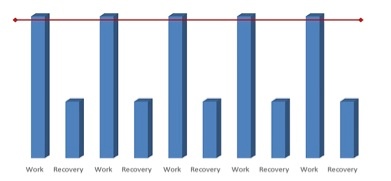
Appropriate recoveries = consistent work performance and consistent calorie burn over successive intervals. 4-min x 5 sets equals 20-minute workout, and breaks out as follows:
- 60-sec HIIT = 20 kcal/min.
- 180 second recovery = 5 kcal/min x 3 = 15 kcal.
- One interval = 35 kcal x 5 intervals.
- Total workout = 175 kcal.
On the other hand, a HVIT workout (Figure 1-4) that many perceive as HIIT training that includes 60-second work and recovery intervals will incur a greater volume of work (100% more work), but a smaller relative differential in expended calories.
For example, while the first few intervals of this workout may expend 20 kcal over the 60-second work interval and just 5 kcal during the 60-second active recovery, this caloric expenditure rate cannot be maintained over the ensuing repetitions. Consequently, while 10 intervals may have been completed the caloric differential between this HVIT and the true HIIT workout may only be marginal, but the risk of injury in the latter intervals may certainly increase.
Figure 1-4: A HVIT workout
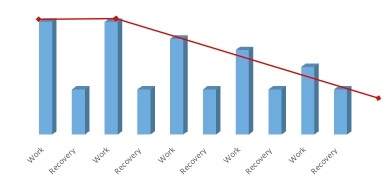
Inappropriate recoveries = reductions in performance and decreased caloric burn.
- 60-second HVIT intervals #1 – 2 = 20 kcal/min.
- 60-second recovery between each work intervals = 5 kcal/min.
- 60-second HVIT intervals #3 – 6 = 17 kcal/min.
- 60-second HVIT intervals #7 – 8 = 12 kcal/min.
- 60-second HVIT interval #9 – 10 = 9 kcal/min.
- Total workout = 200 kcal.
Solutions
In light of the information presented and summarized below in Table 1-3, is there an ideal solution to this growing trend that considers the overall concerns? Herein lies the third type of training – variable-intensity interval training (VIIT), a hybrid form of programming that incorporates the best of HIIT, while simultaneously minimizing some of the concerns associated with HVIT.
Table 1-3: HIIT v. HVIT Summary
As illustrated in Figure 1-5, VIIT includes pre-scripted variations in the intensity of the work intervals performed in order to attain (a) more true HIIT intervals within the overall session that follow appropriate recovery periods – improves performance and may possibly increase EPOC, yet (b) increases the training volume (increasing session caloric burn rate) and perception of work rate, while reducing the potential for injury.
The program may include a few successive intervals of high-intensity work coupled with shorter recoveries representative of HVIT (e.g., 2 – 3 x 60-second work intervals using 30-60 second recovery intervals), then introduces a sequence of intentional lower-intensity work intervals that do not overwhelm the body’s lactate buffer (i.e., enable regeneration). This might involve 1 – 3 sets performed at a sub-maximal performance (below 75% of maximal performance) where the aerobic pathway contributes more significantly.
The workout then returns to another series of high-intensity interval bouts before re-introducing the lower-intensity bouts. The outcome is the best of both HIIT and HVIT, without many of the concerns. Furthermore, this format may also enhance the psycho-emotional impression or experience of the training program.
Figure 1-4: A VIIT program
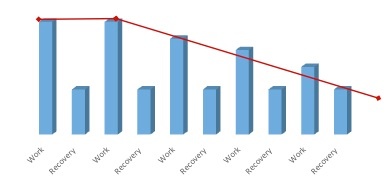
However, one question remains unresolved and it pertains to maximizing work in the minimal amount of time – more specifically to the recovery intervals. Although the recovery needs to remain active to help expedite metabolites (e.g., hydrogen, lactate) out from the muscle cells, they should de-emphasize biological work of the more anaerobic type II fibers within the body in order to facilitate recovery – expediting metabolite clearance, and regenerating the blood lactate buffer.
Subsequently, this offers an ideal opportunity to target the type I fibers with stabilization exercises for balance and postural control, similar to the methodology of Phase 2 training within NASM’s OPT model (Strength-endurance).
As strength and conditioning coaches often do with athletes, this recovery interval provides a great challenge to athletes to demonstrate good postural control through low-active stabilization exercises to ensure good form and technique, while concurrently allowing the lactate buffer and muscles the needed time to recover.
For example, a set of barbell clean and presses (performed for 45-seconds) performed as a superset with barbell side lunges (performed for 30-seconds in each direction) – total of approximately 105 seconds of work may include 210 seconds of recovery (1-to-2 work-to-recovery ratio). An active recovery preceding the next superset of barbell deadlifts and standing kettlebell rear rotational presses could be designed as follows:
- Light movement – walking (10-seconds)
- Plank walk-ups (20-seconds) - learn how to do other plank variations here
- Rotational planks (20-seconds per direction)
- Transition (5-seconds)
- Single-leg swings with hip drivers in all three planes (30-seconds per leg)
- Transition (5-seconds).
- Light Turkish get-ups (20-seconds per side)
- Transition (5-seconds)
- Light movement – walking (15-seconds)
To summarize, true HIIT training holds the purpose of improved performance and is orientated around movement quality. What we perceive to be HIIT, but is actually more aligned with HVIT, is focused upon volume or movement quantity, and perhaps at pursuing a higher caloric expenditure.
One must question the efficacy and the cost of this approach. Remember, workouts where the total work interval performed before taking a recovery interval that exceeds 3 to 4 minutes, or one that is performed at intensities below 75% of maximal performance (e.g., 75% of 1RM) or one that usually involves bodyweight resistance training is most likely HVIT (and not HIIT), and should be defined as such.
However, to truly capitalize on the benefits that each can or may provide, VIIT appears to offer the ‘sweet spot’ where we can attain both needs and desires.
Other Blog Posts to Check out
References:
- Thompson WR, (2014). Worldwide survey of fitness trends for 2015: what’s driving the market? ACSM'S Health & Fitness Journal; 18(6): 8 – 17.
- Human Kinetics (2014). 5 fitness trends to expect in 2015. http://humankinetics.me/2014/10/22/5-fitness-trends-to-expect-in-2015/ (retrieved Nov 11, 2014).
- Brown, JS (2014). Fitness Trend Forecast for 2015: 6 Trends on the Rise. The Huffington Post. http://www.huffingtonpost.com/jill-s-brown/fitness-trend-forecast-fo_b_5753458.html, Updated: 11/05/2014; retrieved Nov, 2014).
- Gibala, MJ, Little, JP, MacDonald MJ, and Hawley, JA (2012). Physiological adaptations to low-volume, high-intensity interval training in health and disease. The Journal of Physiology, 590(5): 1077 – 1084.
- Tabata I, Nishimura K, Kouzaki M, Hirai Y, Ogita F, Miyachi M, and Yamamoto K, (1996). Effects of moderate-intensity endurance and high-intensity intermittent training on anaerobic capacity and VO2max. Medicine and Science in Sports and Exercise, 28(10): 1327 – 1330.
- Gunnarsson TP, and Bangsbo J, (2012). The 10-20-30 Training Concept improves performance & health profile in moderately trained runners. Journal of Applied Physiology, 113(1): 16 – 24.
- Centers for Disease Control and Prevention. Injury episodes and circumstances: National Health Interview Survey, 1997-2007, Vital and Health Statistics, 2009, 10(241). Retrieved 06/15/13.
- Bergeron MF, Nindl BC, Duester PA, Baumgartner N, Kane SF, Kraemer WJ, Sexauer LR, Thompson WR, O’conner GF (2011). Consortium for Health and Military Performance and American College of Sports Medicine consensus paper on extreme conditioning programs in military personnel. Current Sports Medicine Reports, 10 (6), 383–89.
- Vandewalle H, Peres G, and Monod H (1987). Standard anaerobic exercise tests, Sports Medicine, 4: 268 – 289.
- Withers RT, Sherman WM, Clark DG, Esselbach PC, Nolan SR, Mackay MH, and Brinkman M (1991). Muscle metabolism during 30, 60 and 90s of maximal cycling on an airbraked ergometer. European Journal of Applied Physiology, 63: 354 – 362.
- Baechle TR, and Earle WE, (2008). Essentials of Strength Training and Conditioning (3rd). Champaign, IL: Human Kinetics.
- Kenney WL, Wilmore JH, Costill DL, and Kenney WL, (2012). Physiology of Sport and Exercise (5th), Champaign, IL: Human Kinetics.
- Brooks GA, Fahey TD, and Baldwin KM, (2005). Exercise Physiology: Human Bioenergetics and its Applications (4th Ed.). New York, NY: McGraw-Hill Companies.
- Oosthuyse T, and Bosch AN, (2010). The effect of menstrual cycle on exercise metabolism. Sports Medicine, 40(3), 207 – 227.
- Tarnopolosky MA, (2008). Sex differences in exercise metabolism and the role of 17-beta estradiol. Medicine and Science in Sports and Exercise, 40(4):648 – 654.
- LaForgia J, Withers RT, and Gore CJ, (2006). Effects of exercise intensity and duration on the excess post-exercise oxygen consumption. Journal of Sports Science, 12:1247 – 1264.
- Phelian JF, Reinke E, Harris MA, and Melby CL, (1997). Post-exercise energy expenditure and substrate oxidation in young women resulting from exercise bouts of different intensity. Journal of the American College of Nutrition, 16(2), 140-146.
- Knab AM, Shanely A, Corbin KD, Jin F, Sha W, and Neiman DC, (2011). A 45-minute vigorous exercise bout increases metabolic rate for 14 hours. Medicine and Science in Sports and Exercise, 43:1643 – 1648.


